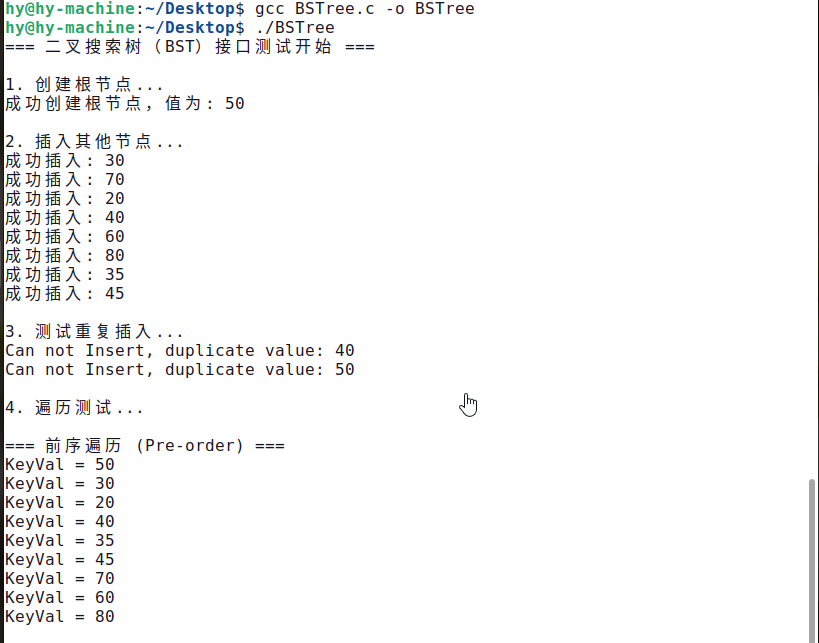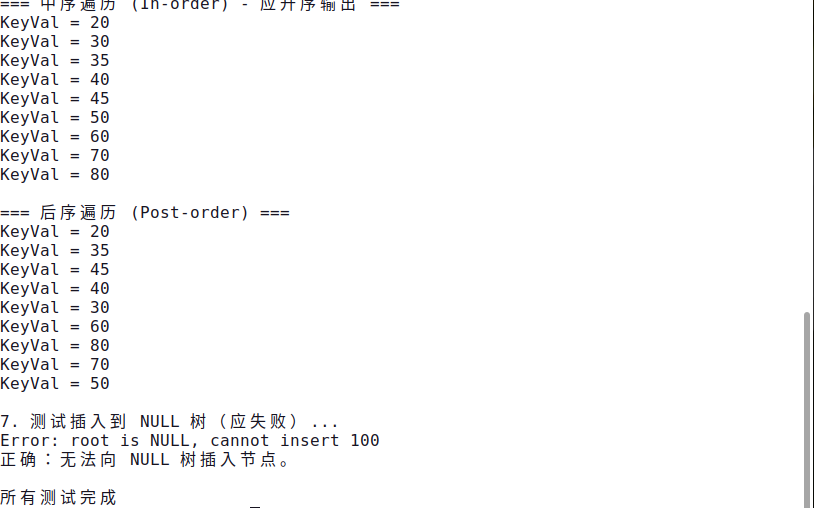二叉排序樹定義
二叉排序樹(Binary Sort Tree),也稱為二叉查找樹(Binary Search Tree, BST)或有序二叉樹,是一種特殊的二叉樹數據結構。以下是二叉排序樹的一些核心概念:
一個二叉排序樹或者是一棵空樹,或者是具有以下性質的二叉樹:
- 右子樹上所有結點的值均大於它的根結點的值
- 左子樹上所有結點的值均小於它的根結點的值
- 左右子樹也分別為二叉排序樹
- 不存在鍵值相等的節點
代碼實現
#include <stdio.h>
#include <stdbool.h>
#include <stdlib.h>
typedef int DataType_t;
typedef struct BSTreeNode
{
DataType_t Keyval;
struct BSTreeNode *lchild;
struct BSTreeNode *rchild;
}BSTNode_t;
BSTNode_t* BSTree_Create(DataType_t KeyVal)
{
BSTNode_t *root = (BSTNode_t *)calloc(1,sizeof(BSTNode_t));
if(root == NULL){
perror("Calloc memory for the root is failed!\n");
exit(-1);
}
root->lchild = NULL;
root->rchild = NULL;
root->Keyval = KeyVal;
return root;
}
BSTNode_t* BSTree_NewNode(DataType_t KeyVal)
{
BSTNode_t *New = (BSTNode_t *)calloc(1,sizeof(BSTNode_t));
if(New == NULL){
perror("Calloc memory for the New is failed!\n");
return NULL;
}
New->lchild = NULL;
New->rchild = NULL;
New->Keyval = KeyVal;
return New;
}
bool BSTree_InsertNode(BSTNode_t* root, DataType_t KeyVal)
{
if (root == NULL) {
printf("Error: root is NULL, cannot insert %d\n", KeyVal);
return false;
}
BSTNode_t *New = BSTree_NewNode(KeyVal);
if (New == NULL) {
printf("Create NewNode Error\n");
return false;
}
BSTNode_t *Proot = root;
while (Proot != NULL) {
if (KeyVal == Proot->Keyval) {
printf("Can not Insert, duplicate value: %d\n", KeyVal);
free(New); // 避免內存泄漏
return false;
}
else if (KeyVal < Proot->Keyval) {
if (Proot->lchild == NULL) {
Proot->lchild = New;
return true;
}
Proot = Proot->lchild;
}
else {
if (Proot->rchild == NULL) {
Proot->rchild = New;
return true;
}
Proot = Proot->rchild; //
}
}
return true; //
}
//前序遍歷
bool BSTree_PreOrder(BSTNode_t* root)
{
if(root == NULL)
{
return false;
}
printf("KeyVal = %d\n",root->Keyval);
BSTree_PreOrder(root->lchild);
BSTree_PreOrder(root->rchild);
return true;
}
//中序遍歷
bool BSTree_InOrder(BSTNode_t* root)
{
if(root == NULL)
{
return false;
}
BSTree_InOrder(root->lchild);
printf("KeyVal = %d\n",root->Keyval);
BSTree_InOrder(root->rchild);
return true;
}
//後序遍歷
bool BSTree_PostOrder(BSTNode_t* root)
{
if(root == NULL)
{
return false;
}
BSTree_PostOrder(root->lchild);
BSTree_PostOrder(root->rchild);
printf("KeyVal = %d\n",root->Keyval);
return true;
}
int main()
{
// --- 1. 測試:創建根節點 ---
printf("1. 創建根節點...\n");
BSTNode_t* root = BSTree_Create(50);
if (root) {
printf("成功創建根節點,值為: %d\n", root->Keyval);
}
// --- 2. 測試:插入多個節點 ---
printf("\n2. 插入其他節點...\n");
int values[] = {30, 70, 20, 40, 60, 80, 35, 45};
int n = sizeof(values) / sizeof(values[0]);
for (int i = 0; i < n; i++) {
if (BSTree_InsertNode(root, values[i])) {
printf("成功插入: %d\n", values[i]);
}
}
// --- 3. 測試:重複插入(應失敗)---
printf("\n3. 測試重複插入...\n");
BSTree_InsertNode(root, 40); // 已存在
BSTree_InsertNode(root, 50); // 根節點已存在
// --- 4. 測試:遍歷操作 ---
printf("\n4. 遍歷測試...\n");
printf("\n=== 前序遍歷 (Pre-order) ===\n");
BSTree_PreOrder(root);
printf("\n=== 中序遍歷 (In-order) - 應升序輸出 ===\n");
BSTree_InOrder(root);
printf("\n=== 後序遍歷 (Post-order) ===\n");
BSTree_PostOrder(root);
printf("\n7. 測試插入到 NULL 樹(應失敗)...\n");
BSTNode_t* emptyTree = NULL;
bool result = BSTree_InsertNode(emptyTree, 100);
if (!result) {
printf("正確:無法向 NULL 樹插入節點。\n");
}
printf("\n所有測試完成\n");
return 0;
}
根節點的值是50,主函數中依次插入節點:30, 70, 20, 40, 60, 80, 35, 45,所以這棵樹的圖像長這個樣子














